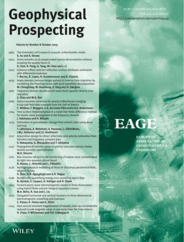
Full text loading...
We present a concept of the hybrid finite volume–integral equation technique for solving Maxwell's equation in a quasi‐static form. The divergence correction was incorporated to improve the convergence and stability of the governing linear system equations which pose a challenge on the discretization of the curl–curl Helmholtz equation. A staggered finite volume approach is applied for discretizing the system of equations on a structured mesh and solved in a secondary field technique. The bi‐conjugate gradient stabilizer was utilized with block incomplete lower‐upper factorization preconditioner to solve the system of equation. To obtain the electric and magnetic fields at the receivers, we use the integral Green tensor scheme. We verify the strength of our hybrid technique with benchmark models relative to other numerical algorithms. Importantly, from the tested models, our scheme was in close agreement with the semi‐analytical solution. It also revealed that the use of a quasi‐analytical boundary condition helps to minimize the runtime for the linear system equation. Furthermore, the integral Green tensor approach to compute at the receivers demonstrates better accuracy compared with the conventional interpolation method. This adopted technique can be applied efficiently to the inversion procedure.

Article metrics loading...

Full text loading...
References


Data & Media loading...

